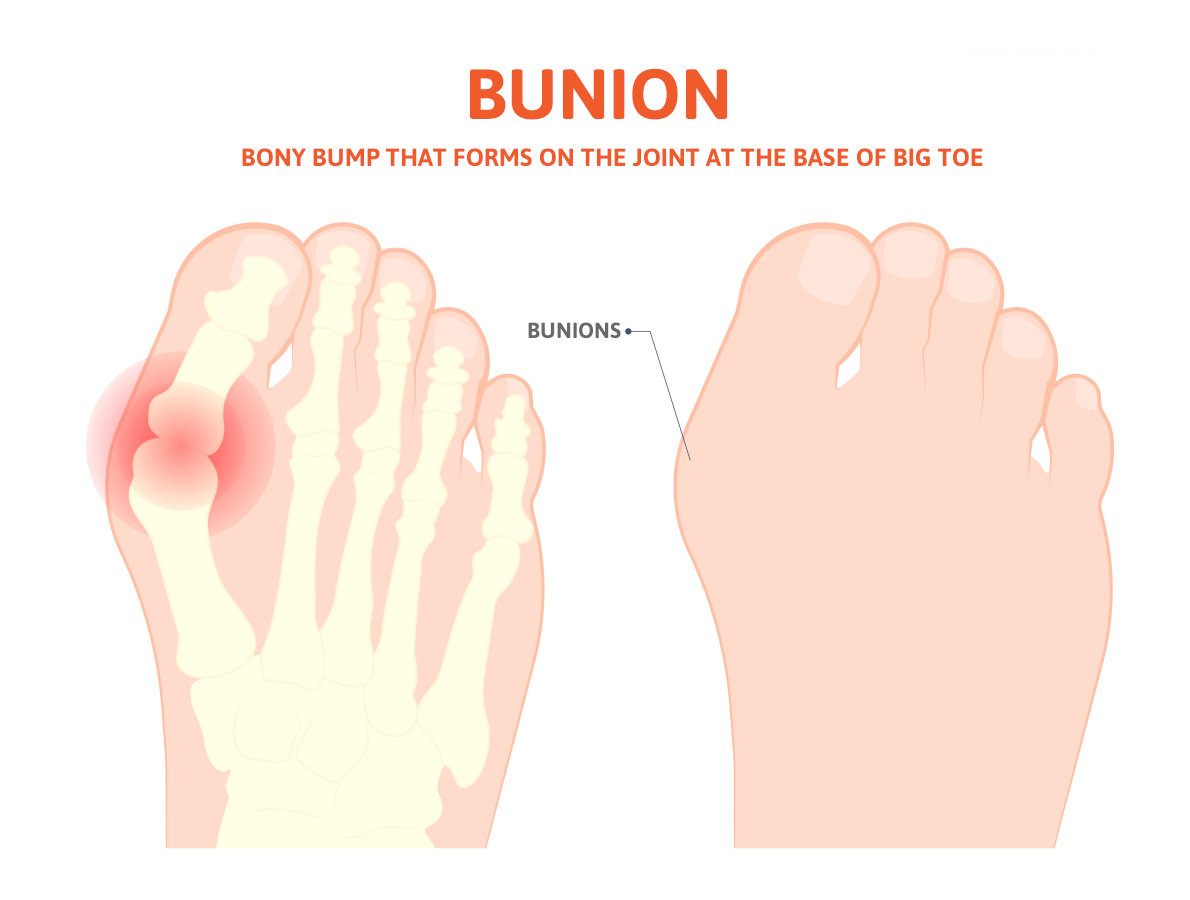
Bunions can be a painful foot condition for many. They can become painful and make finding a comfortable pair of shoes to wear very difficult. Foot surgery for bunions should be not only be considered for the asthetical value, but the overall bony health and balance of the body.
What is a Bunion & What Causes a Bunion?
There is a primary problem that creates a bunion, which starts as the big toe begins to anglalate towards the smaller toes. The metatarsal bone at the base of the digit moves away from the rest of the foot causing an increased angle. This increased angle is between the first and second metatarsal bones. The results are a hard bony prominence at the base of the big toe. The medical term for this condition is Hallux Valgus.
The primary cause is thought that poor foot mechanics may be the main cause. Too much weight may be placed beneath the great toe joint, and it changes the pull of the tendon around the great toe which starts the process. Also, wearing shoes such as high heels that are pointed or too tight may also be a cause.
Non Surgical Treatments
When it comes to bunions, there are multiple non-surgical options to tryout:
- Change in Shoe Gear – Try to avoid shoes that are too tight and purchase shoes with a larger toe box
- Padding – Placing more cushion on the area may also provide temporary relief and the use of anti-inflammatory drugs
- Orthotics – Custom made shoe inserts called orthotics may also be useful
Surgical Treatment Option for Bunions
For many, the surgical correction becomes the treatment of choice. When it’s difficult to wear the majority of shoes this may be the appropriate treatment.
We can discuss three basic approaches to correcting the bunion. To begin with the problem lies in the angulation of the first metatarsal away from the second metatarsal bone. This is what causes most of the bony prominences that rub against the shoes. This angle needs to be reduced so the two bones are more parallel. By accomplishing this angle correction, it is easier to straighten the big toe. Many years ago, bunion surgery had a bad reputation because doctors would simply remove the bone bump and not address the angulation of the bone. Thus, for many, this only offered part-time relief.
How is the angle corrected? It can be done in three general ways:
- By shifting the bone close the great toe joint
- By shifting the bone by the base of the metatarsal bone closer to the instep
- By removing a portion of the great toe joint
It is also important to note that what procedure the foot and ankle surgeon choses is based upon the severity of the bunion deformities and the patient’s age.
Three Types of Foot Surgery for Bunions Performed
- There is the option of shifting the bone by the great toe joint. The vast majority of toe time, this procedure is performed at Anderson Podiatry Center. The technique is used for more mild or moderate bunions. The recovery from this is usually wearing a surgical shoe or Cam walker for 3-4 weeks and just a few days of non-weight being in the beginning.
- The option of shifting the bone at the base closer to the ankle usually requires more lay-up time of weeks after surgery, usually 4-6 of off- weight bearing. This procedure is reserved for more severe deformities and may only comprise ten percent of the bunion corrections that we do.
- This final option is to remove a portion of the great toe joint. This can work very well in the senior population over 65 years of age. There is very little risk and has been performed successfully in patients in their 80’s. For all these surgical options, the affected foot will need to be elevated after surgery for several days and weight bearing can resume within days or weeks depending on what surgical approach is performed. Physical therapy may also be recommended during the surgical recovery. When you can return to normal activity level will also vary.
Below, I have a few notes in regards to bunion surgery and occurrence.
Surgical Setting: These surgeries are performed on an outpatient basis using local anesthesia and IV Sedation. Depending on the circumstance, both feet may be done at once.
Recurrence Rates: The possibility of recurrence of the bunion is very minimal especially if the foot and ankle surgeon is shifting the first metatarsal bone, and not simply removing the bunion bump.
Why Early Treatment May be Advantageous
Foot Surgery for bunions should be carefully considered and should not be done for cosmetic reasons. Once there is pain and shoes are becoming a challenge, surgery before the bunion becomes more severe may be best. Why? Simply because of lay-up time. This is something few patients are aware of. Many assume it may be weeks of not bearing weight on the foot. This is not the case for many patients. The majority of corrections we perform allow you to place weight on the foot within a few days.
Call us today at our Fort Collins location (970) 329-8158, Broomfield location (303) 997-2795, Surgery Center (970) 329-8158, or use our online scheduling system to book your appointment.
We can find a solution for you!






